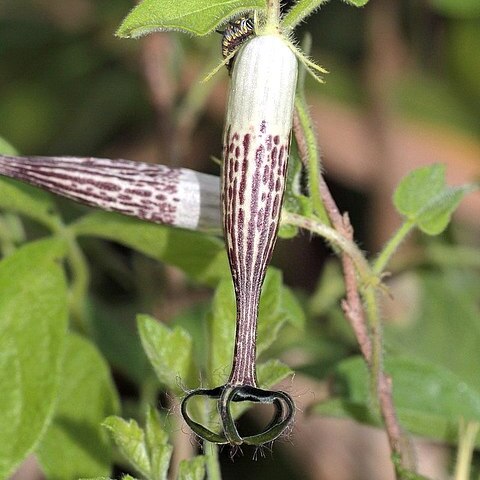Geophytic, herbaceous twiner-climber. Stems annually produced from discoid tubers, 0.5-2.0 m long, hairy. Leaves ovate-lanceolate to ovate, 19-50 x 8-30 mm, base rounded or cordate, herbaceous, hairy, margins entire, variably dentate, slightly undulate; petioles 8-32 mm long. Inflorescences 2-4-flowered, produced at nodes; pedicels 5-20 mm long. Corolla 40-60 mm long; tube straight, erect, bottle-shaped, 25-38 mm long, basal inflation elliptic-oblong, 16.5-25.0 x 6-9 mm, narrowing above into a short neck 2-3 mm in diam., then abruptly dilating at mouth 5.5-7.0 mm in diam.; lobes linear, 9-11 x 3 mm, curving and becoming connate to form triangular openings in a 5-sided cage; margins revolute and velvety with crinkled hairs. Gynostegial column stipitate. Corona: interstaminal corona lobes connate basally to form a shallow sunken platform, 1.0-1.5 mm deep; staminal corona lobes fused basally to interstaminal corona, free above, erect, linear, ± 2 mm long, connivent on anther backs and exceeding style-stigmahead, forming a loose cage.
Twining perennial herb. Plants pubescent. Leaves ovate-cordate to lanceolate, often coarsely toothed. Corolla 40-60 mm long, glabrous outside or with few hairs, cage ± rounded, tube bottle-shaped. Flowers white or greenish white on lower half, longitudinally purple-brown or violet-dotted or-striped in upper half, lobes velvety black with longitudinal green stripes and long crinkled cilia.
A climbing herb. It keeps growing from year to year. It puts up annual stems from a tuberous disc like rootstock. The leaves are opposite and oval. They have wavy edges. The flower are tube shaped and white. They have a structure that looks like a cage at the top. The fruit are in 2 erect follicles. They are narrow and 10 cm long.

